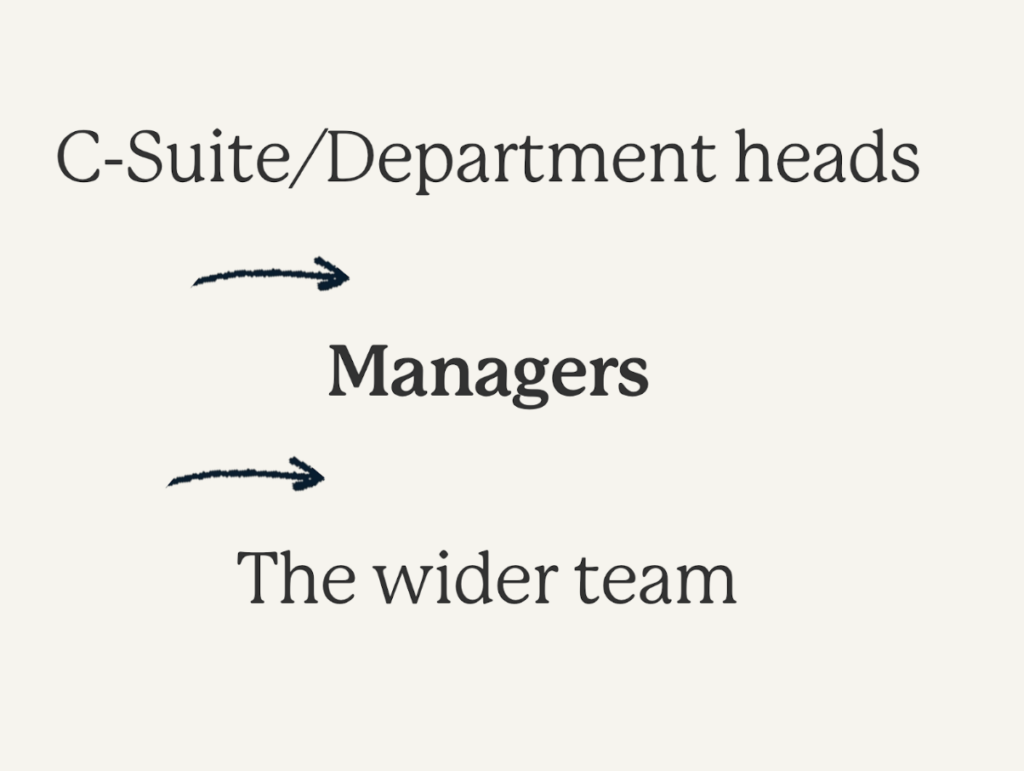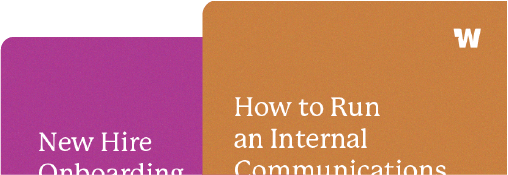How to bridge the communications gap with managers

Managers have it hard in an organization. They’re tasked with communicating ideas from leadership to the wider team, getting results, AND sending important information back from the front lines. “Middle management” has become a somewhat cringy term… but it doesn’t have to be! Internal communications can activate and enable managers to create healthy, helpful, active communications to ALL levels of the company. We’re here to help!
The communications gaps happen here:

What happens when company communication gaps aren’t fixed?
Leaving communications gaps can cause great strategies, brilliant products, game-changing ideas… to fall flat. The point is lost in translation and team leaders get blamed for bad execution. The workforce is left out, alienated from the decision-making that’s behind what’s happening to them. And the people making the decisions aren’t getting the feedback they need from the workforce to form strategies that will work.
What makes managers special?
The managers in your company frequently come from within the area of expertise, or even directly from the team they manage. Think about that. That makes them unique experts in a few different ways, and puts them in a unique position with the staff.
- Frontline managers have a higher level of trust with staff. Leaders with direct frontline experience can share information from a “been there” perspective.
- Information shared by middle managers is more likely to be understood and change more likely to be embraced. They know the voice. They get the “pain points” of the team. And they can relate directly to factors that might make stuff feel negatively about change.
- Managers are the best at giving WIIFM to their teams. That’s “What’s In It For Me,” frequently the first response to new information.
- Managers are practical and tactical. They have to be. A manager’s performance depends on their team’s performance, so they will be the best translators of strategy into day-to-day actions that get results.

How do we fix it?
In order to create internal communications plans that inspire, inform, and include managers, and empower them to do the same for their teams, we recommend focusing on five areas.
- Share vision and priorities
- Plan the flow of information
- Ask for feedback (and show how you’re using it)
- Meet managers where they are
- Provide communication resources and training
Share vision and priorities
Research has shown that as high as 88% of employees are more engaged when they understand the company’s vision and priorities. So bring them in! Managers can play a role here, but we always recommend sharing information from the top… actually from the top. Start with a direct share from leadership, and trust your employees to follow and fill in the context for their teams.
CEO communications
If you don’t currently have a regular leadership newsletter or update going out, we highly recommend it. You can, of course, use ghostwriting or strong nudging from the communications department, but the value that you get from employees all around the company hearing about what’s going on directly from decision makers is a really big deal.
With Workshop’s ghostwriting feature, you can write memos, newsletters, announcements, and on-brand emails on behalf of your chief executives! And with user permissions, you can choose who your team can ghostwrite for (and which lists and teams they can send to).
Sending emails from an executive or a department head instead of a catchall team email is a surefire way to boost your open and engagement rates (which are all easily tracked through Workshop). Plus, it provides the company with even more visibility into your leadership team…something we know almost every organization is looking for!
This weekly CEO update template is one of our favorites (and works for leaders of any team, really).
Managers-only newsletter
With CEO or leadership comms in place, you can focus specifically on strategies designed to fill the communications gaps that are still there with your managers. To assist your best leaders with communicating with their teams and gathering feedback – and to help your not-so-best managers get there – send outreach that ONLY goes to them.
Manager-specific comms can (1) help them understand what’s coming down the pike from leadership and why, (2) give details about timing and accountabilities to lead implementation, (3) lay out the nitty gritty details that are going to affect their teams.
An ideal newsletter template provides a look up at the top at the topics covered and then dives straight into what managers care about. Under each update or topic, we like to include what’s going on and why, plus the dates, talking points, and resources a manager is going to need to get their team members on board.
Try the format, “What to Know, What to Do, What to Share” to boil all this down and make something a manager can come back to whenever they need.
Managers-Only Segmentation
Or you can create managers-only rows in your regular emails and newsletters. A good internal email tool (like Workshop) will let you do this – only recipients in a certain list will be able to see the content you add. In a manager’s-only sub-section of your newsletter, you can provide team direction, new hire announcements, reminders of things they need to ask their teams to do, and more.
Plan the flow of information
To cascade communications or not to cascade? Mass communication or planned hand-offs? Written or video? The communications model you lay out for your initiative always takes nuance – it depends on the information, the way your company is shaped, the internal culture, the potential impacts… Here’s where we start!
Share from the “highest” level appropriate for the information
That doesn’t mean everything should come from the CEO, it means that if you don’t have to cascade – don’t. Look at what you’re sharing, and use the voice closest to the source that’s appropriate.
Include as many audiences at once as you can
Don’t make someone tell someone else if there isn’t a good reason they could hear the information at the same time! Double check your audience groups are as inclusive as possible at every stage.
Prepare for follow-up and questions in the right places (managers!)
Make it part of your comms plan to equip team leaders every time. Whether the information initially comes from the CEO or from the manager, the frontline team leaders should be the ones with all the answers.
A communications cascade template
A great place to start is with our free communications cascade template. It will help you think through your planned communications and see everything in one place. You’ll see how all employees will get the information they need and from whom, make sure they can find the resources they need for success, and organize where and how feedback is shared. This communications cascade template also has a communications brief attached to help you think through the comms plan.
Ask for feedback (and share how you’re using it)
Create a culture of continuous feedback
Continuous feedback is really another way to talk about bridging the gaps. It means information is flowing up and down, and that your communication strategy informs and includes at all levels. Staff can give feedback to managers, who in turn can give feedback to leadership, staff can give feedback directly to leadership, and leadership and managers show how feedback is implemented.

Feedback gathering ideas
- 1-on-1 meetings at every level
- Q&As at all-hands/town hall/departmental meetings
- Digital “suggestion box” on the company intranet
- Email! Implement pulse surveys and open up replies
Pulse surveys and replies
Pulse surveys are the quickest way to get feedback from a large group. You can run a short Google or Survey Monkey survey, sure, but results are usually “okay,” because people have to take a number of steps to complete the survey. Workshop gives you the ability to actually embed these pulse surveys straight in the content of your email, so they never have to leave the window to give you a rating, score, or comment.
If you don’t want to embed surveys, you can also just ask for replies in an email. We love when companies do this for letters from the CEO as a way to get open feedback from anywhere around the company.
Manager focus groups
If your structure doesn’t allow for middle management representation in the room when decisions are made, use what you have! You should use regularly scheduled middle-manager touch-bases for
- Sharing upcoming changes, announcements and initiatives
- Gathering feedback from them and their teams
- Understanding sentiment from the wider organization
Meet managers where they are
What managers want – and very often feel that they don’t get – to be great at their jobs is autonomy and responsibility. To be brought in and included in the information that’s important to them, and trusted to convey it as they will. Give them a chance to influence the details of the change, or at least the communication plan. Combined with a communications cascade, this means everyone in the organization is (1) speaking from their unique place of authority and influence, (2) conveying the parts of the message that matter to their audiences, and (3) knows what they’re talking about.
Teaching leaders how to communicate isn’t just about more (or even better) presentations. It’s about helping them with:
- Listening: Creating situations where team leaders are able to hear their teams needs and wants, giving them a space to react and ask questions
- Facilitation: Making sure managers are able to do something with the information they get from their teams
- Collaboration: Connecting managers to each other and others in the organization who can help
Creating a community for collaboration
Use Teams or Slack or an intranet – whatever you’ve got – where managers can learn from each other, find resources to learn how to communicate more effectively, and access previous manager-focused communications. It’s a good idea to help your managers spark interesting conversation with prompts or questions. We find being specific, rather than broad, helps create useful insights. Try these –
- What’s a one-on-one question that you’ve found really beneficial?
- What’s the general sentiment around ____?
- Did you receive any questions about ____?
- Which company value do we emphasize the least?
FAQs and FAQ Templates
Create a giant pile of FAQs and answers for your managers! You can approach this from a general or company perspective, and for individual communications. Going through this process can help you anticipate their reactions, and that might make you reconsider or refine your strategy.
For a major company change or communication, thinking through the manager feedback loop should be part of your overall communications plan. Remember, it’s the managers who’ll handle the conversations and practical advice that should follow company-wide news. Try using our Manager FAQs template to think through all the information and possibilities, and distribute to your management team whenever you need to.
Whether you use the FAQ template or not, make sure your managers know not to parrot your words exactly. Remember, a lot of their power and authority comes from that unique position among their team! An internal email tool like Workshop gives power and distribution lists to anyone you choose and actually lets them create and send their own communication.
Provide communication resources and training
As the Workshop comms team researched the manager comms gap for our webinar, we came across this pair of mind-blowing statistics.
91% of employees think their manager lacks effective communications skills
66% of managers are uncomfortable communicating with employees
That’s a serious lack of confidence from every direction! To us, that means… resources! Part of the job of communication facilitation is to share useful tips and tools to your managers and wider teams. Here’s our shortlist of helpful things to provide at your organization.
Meeting agendas
Help leaders communicate and connect with their team with easy-to-follow and consistent agendas for meetings that matter. Encourage them to use 1:1s to get that feedback that moves information through the organization, and/or hold team meetings that specifically address updates and comms. Have them close out meetings by asking for feedback, or sending those little “tell me one thing we could do better” messages.
Conversation guides
Build out conversation guides. A conversation guide is a structured framework that helps facilitate discussions between managers and their teams on specific topics or initiatives. It gives them a roadmap for engaging their team members in great conversations, getting feedback, and addressing concerns.
Mini-trainings and one-sheeters
There isn’t time to send everyone to training for everything! Not even close. But as a communicator, you can create visually engaging “mini-trainings” (use Canva!) to help managers understand and implement new initiatives or policies.
You can create these to build better structure and accountability around touchpoints like performance reviews, one-on-ones, town halls. Training docs also work as additional support materials for things that you’re putting extra focus on, like remote communication or inclusive language. It’s just a really nice, quick, visual way to present that information.
Branded comms templates
Managers are experts, but not necessarily at communications. Offer your team leaders a framework to work within, including templates for various types of communication such as team updates, performance feedback, or project announcements. Guidelines ensure consistency while allowing room for customization. Workshop equips your team with super easy-to-use templates that will help activate your management team to look and sound better!
Share analytics and data
If you’re enabling your managers to send their teams comms from them with an email tool, they’ll also get the engagement and analytics for those messages. Again, this is pretty effortless with something like Workshop. Perhaps the engineering team isn’t opening internal emails, or the sales team engages best with emails that are sent on Fridays. You can work directly with those department leaders to continually improve engagement with future announcements.
Inspire, inform, include… and empower!
Remember, the manager communications gap doesn’t have to exist. Build your communications strategy with a focus on activation of the right people and creating super-helpful managers equipped and empowered to help their teams. An easy-to-use internal email tool like Workshop can help you create and manage communications AND feedback, moving information up and down throughout your company. Good luck!







